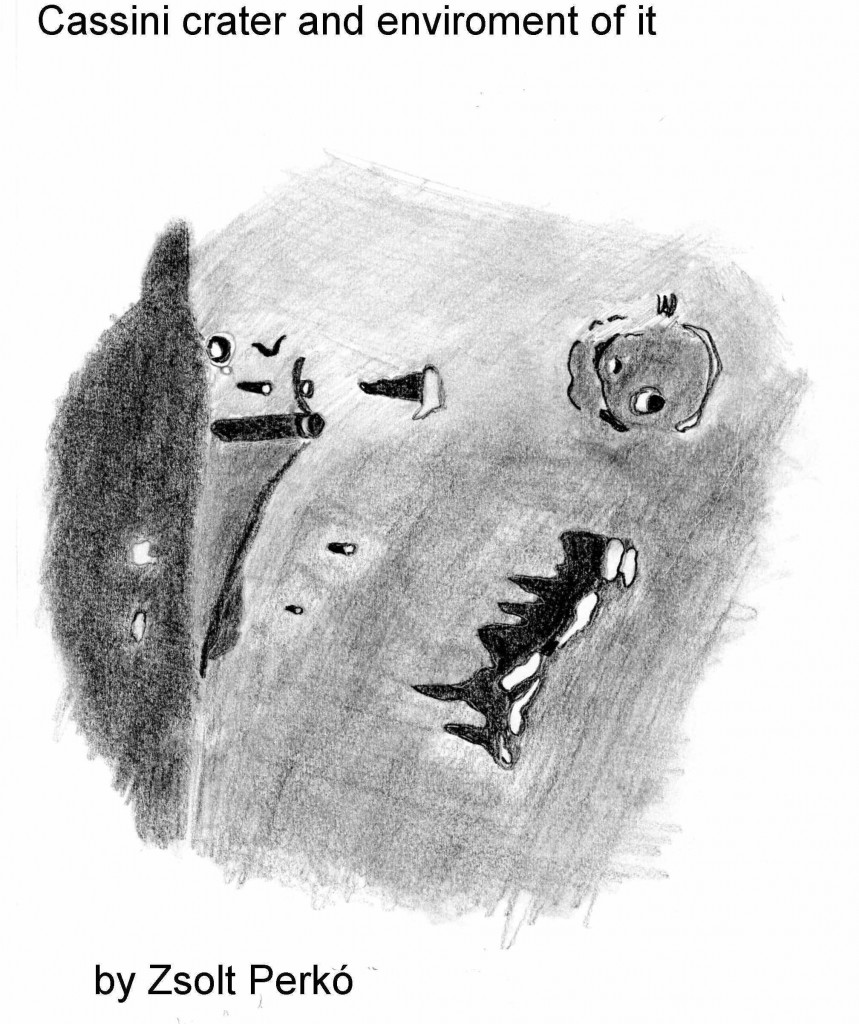
Object Type: Lunar Crater
Location: Hungary-Becsehely, Canis Minor Observatory
Date: 2011-july-08 UT19:00-20:00
Media: graphite pencil, white paper
Object Name: Cassini crater
Meade LX200 GPS 16″, 153x
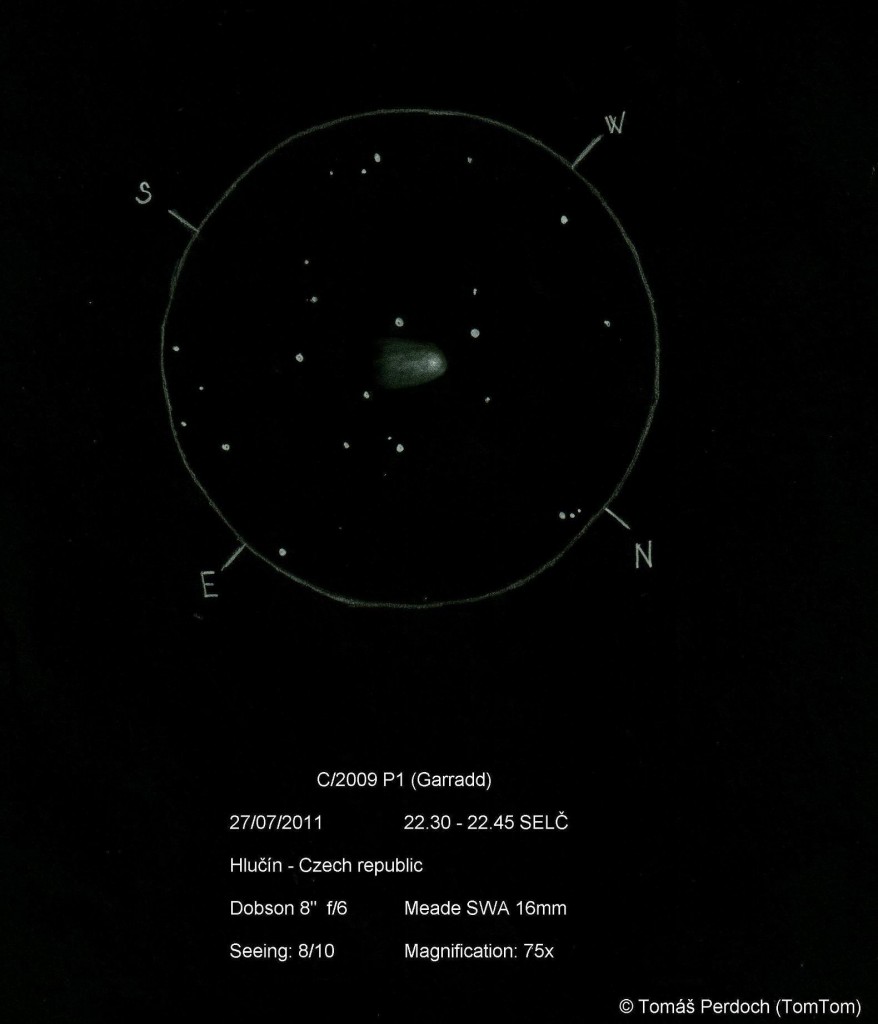
Good morning,
I sketched Garradd last Wednesday. It is my first sketch of comet.
Garradd – Tom Perdoch
C/2009 P1 (Garradd)
Comet
Hlucin (CZ)
27/07/2011 _ 22.30 – 22.45
Pencil on white paper – inverted in Photoshop
It’s my first sketch of comet in my life. I saw this comet first time. I use Dobson 8″ and Meade 16mm SWA. It was first good night in July. I hope it won’t be the last sketch of this comet.
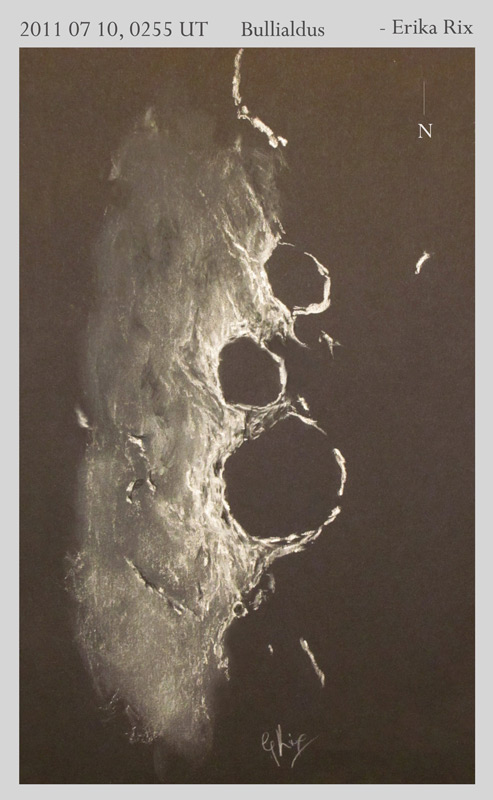
2011 07 10, 0255UT Bullialdus
Erika Rix, Ohio, USA – www.pcwobservatory.com
Bulllialdus: Complex crater from Copernician period (-1.1 billion yrs to present day), Lat: 27.7 deg south, Long: 22.2 deg west.
Zhumell 16”, 21-7mm Zhumell, 257x, no filter
Eyepiece sketch on Strathmore Artagain paper, Conte’ crayon, charcoal
Temp 20C, 92% humidity, S: Antoniadi III, T: 2/6
Phase: 65.5deg, Lunation: 8.75d, Illumination: 70.7%
Lib. Lat: +5deg21’, Lib. Long: +2deg21’
Az: 212deg51’, Alt: 23deg30’
My first thought was to get out my Rite in the Rain paper and charcoal, but that terminator line was looking very dramatic and I decided to try another lunar sketch with black paper and white pastels. I chose the white on black because it can be a lot quicker to draw highlights than to draw shadows and I knew there would be a race against time to sketch on the terminator line. Thanks to my friend, Rich Handy, for introducing me to this media. I’ve found it invaluable for my h-alpha solar work.
Something didn’t really look right to me during my observation. It was only when I called it a night and came back in the house that I realized that Bullialdus A looked a lot larger (and Bullialdus B for that matter) than normal. There’s not a real sharp northern edge to Bullialdus A. It almost has a plateau-like bridge connecting it to the crater Bullialdus. The lighting played against that (or that explanation seems reasonable to me) to make it appear larger than normal.
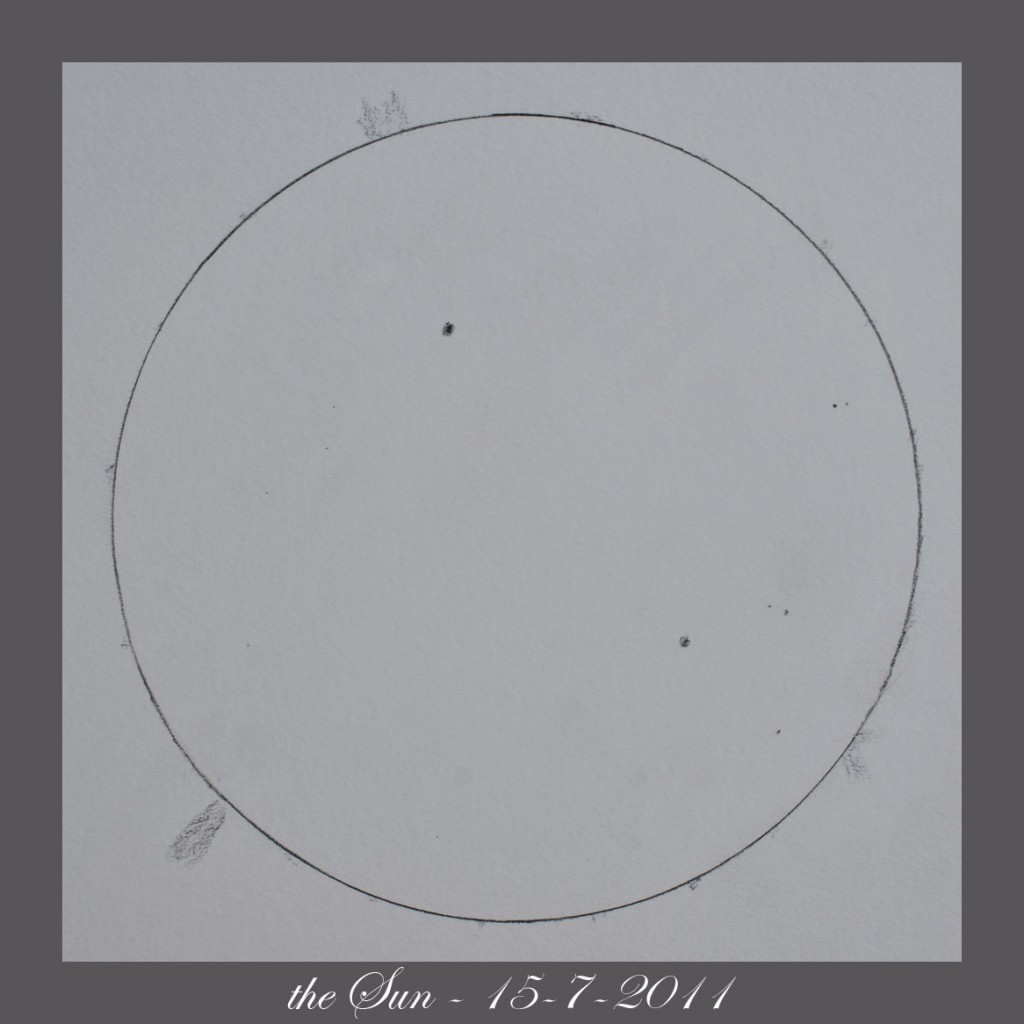
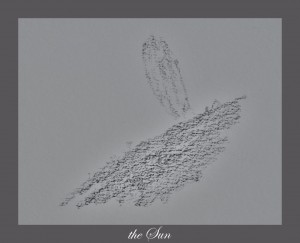

– Location: Lith, the Netherlands
– Date: 15-7-2011
– Media: pencil sketch on white paper
The sky was very clear today. So I aimed my Coronado Personal Solar Telescope (P.S.T.) at the Sun.
Our star was pretty active. I could see some sunspots and a few prominences.
The first sketch is a simple drawing of the disk of the Sun. You can see the sunspots and prominences.
The other two sketches are from the same prominence, in the lower left of the sun’s disk.
Thanks for watching!
Rutger Teule
www.rutgerteule.com
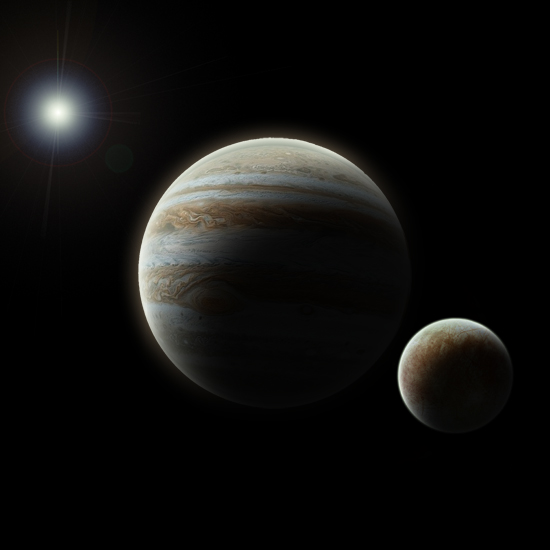
Object Type (Planet, moon)
Location (At Home)
Date (16-07-2011)
Media (Photoshop CS2)
Due to bad weather it is not possible for some time to observe the sky. That’s why I tried some in Photoshop.
It is a digital impression of Jupiter with Europa in the foreground.
It is my first try, hope you’ll like it.
—
Best regards,
Bert Schwertman
The Netherlands
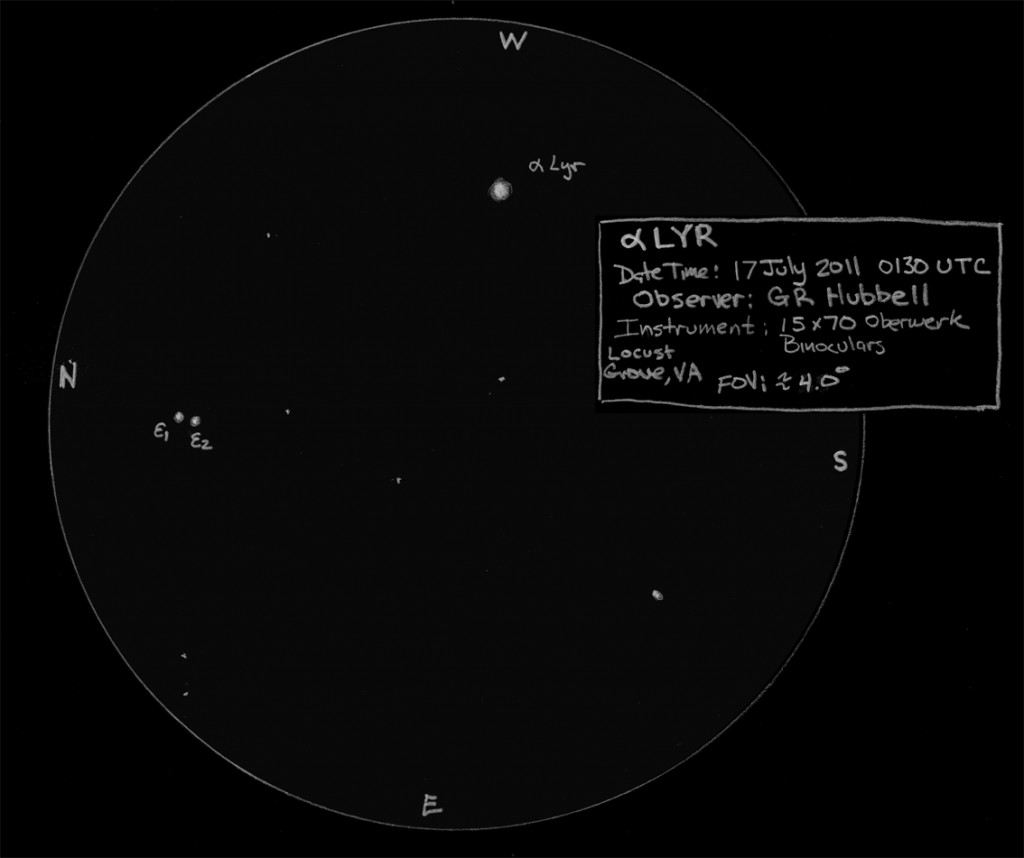
This is my first attempt at sketching a star field.
Object Name: Alpha Lyra – Epsilon 1 & 2 Lyra
Object Type: Double Star
Location: Locust Grove, VA
Date: 17 July 0130 UTC
Media: Graphite #2 Pencil on white paper. Photoshop inversion, enhancement.
Instrument: Oberwerk 15 x 70mm Binoculars
Weather: Clear/Partly Cloudy, 80 degF, Seeing 4/5, Transparency 4/5
Notes: Alpha Lyra drew my attention right at the end of twilight, and it was a beautiful sight with the Epsilon 1&2 double nearby. I could not quite discriminate (split) Zeta 1&2 to the lower right of Alpha, but I could tell it was elongated showing a hint that it was double.
Jerry Hubbell
Lake of the Woods Observatory (MPC I24)
Locust Grove, VA
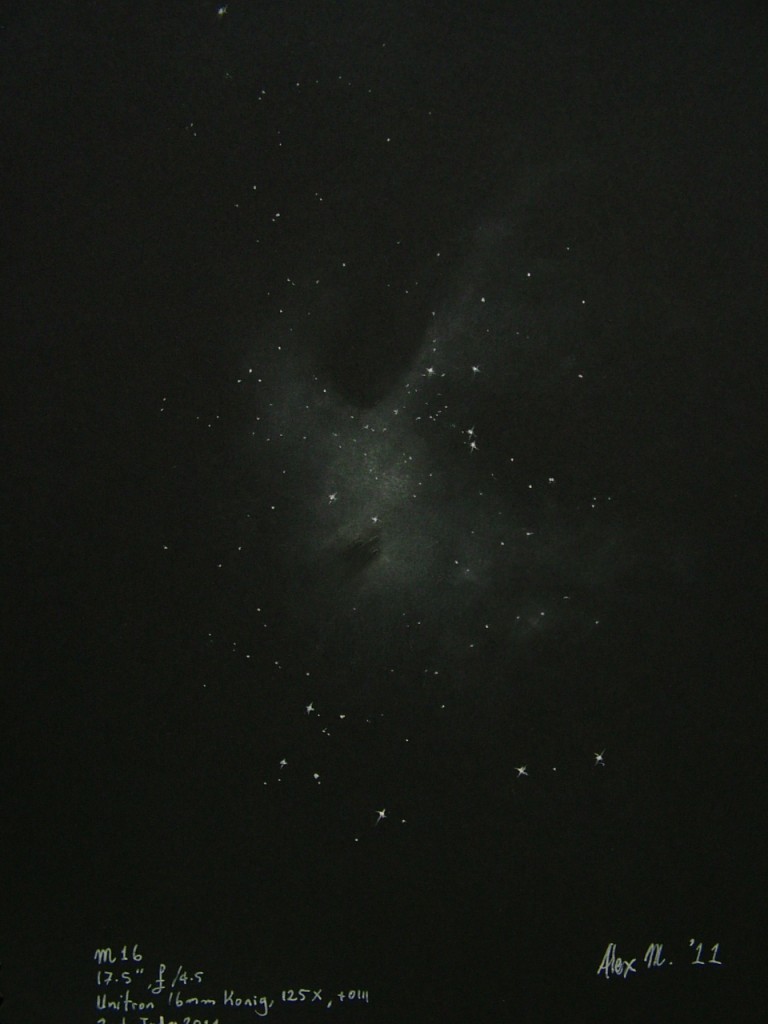
Hi all,
HOORAY! A clear dark sky!
This was my first visit to Wiruna, the dark sky site of the Astronomical Society of New South Wales (many thanks to Alex Comino for organizing my stay there 😉 ). This was the stomping ground of Scott Mellish, and it was such a great experience to meet some of his friends up there. He is so sorely missed.
Conditions started marvelously. Using my 17.5” dob, my first squiz of M16, had me gasping “There it is! There’s the Eagle!” So clear was the dark pillar system. So much so that I could also make out the distinct highlighted leading edge of the pillars! Even with an OIII filter! So cool!
This sketch of the Eagle took around two hours to complete.
It was also my first use of another treasure of an eyepiece, a Unitron 16mm Konig eyepiece. What a marvelous eyepiece! Not as long in eyerelief as newer eyepieces, but the image is one of the brightest I’ve seen, and easily has a 70* FOV.
Object: M16, The Eagle Nebula
Scope: 17.5” f/4.5 dob, push pull
Gear: Unitron 16mm Konig, 125X, + OIII filter, 33.6’ AFOV
Date: 2’nd June, 2011
Location: Wiruna, Ilford, Australia
Materials: White pastel, black & white charcoal pencils and white ink on A4 size black paper
Cheers,
Alex M.
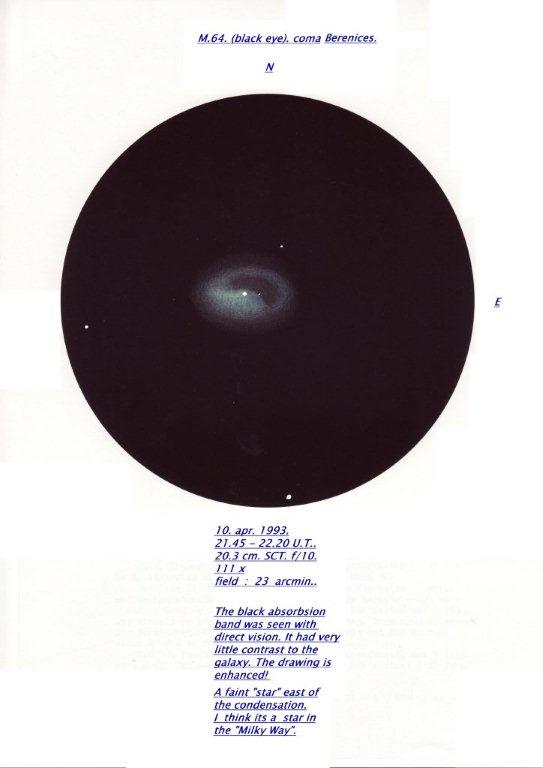
Hey Artists!
I send you M. 64 (Black eye).
It is a lens-shaped galaxy with a bright core. The dark band was seen, but the contrast was low.
A faint star was seen just east of the core, but I think its a star in our “Milky way”.
The outer part of the galaxy was diffuse and difficult to see an edge. Info on my sketch.
The sketch was made from Trondheim, Norway with crayons on black paper.
Best wishes from Per-Jonny Bremseth.